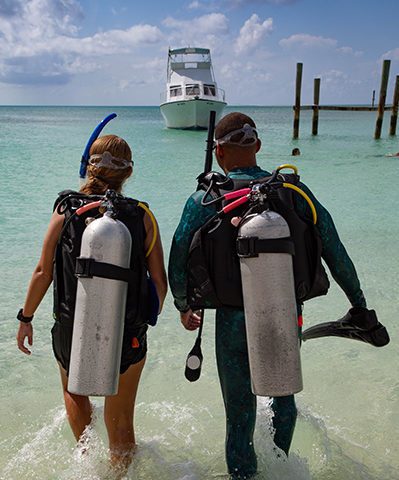SHORE
DIVING
SAFETY

JUST AS BOAT DIVING INVOLVES SPECIFIC HAZARDS, so does diving that doesn’t involve a boat. Whether you wade through crashing surf, descend a flight of stone stairs, or jump from a platform, you’ll want to consider a few relevant concerns when diving from shore.
ASSESSMENT OF
DIVE CONDITIONS
Divers know that conditions can change rapidly, and conditions that are perfect in the morning may become unsuitable later in the day. Some places have weather or current conditions that are so variable they might change while you are underwater.
It is important to not only make an initial dive site assessment, but also to continue evaluating conditions during the dive until it is completed. Changing conditions might affect dive plans such as entry and exit procedures, so it is important to pay attention during the assessment to better ensure the safety of divers.
EQUIPMENT
CONSIDERATIONS
Dive sites might have restricted or challenging access, especially when located off the beaten path. Additionally, in the case of an emergency, other equipment may be necessary for evacuation. These challenges may be exacerbated without proper equipment.
Assess your need for support equipment such as ladders, ropes, or other devices that facilitate access. Communications equipment should also be included; make sure it is in working order and reliable at the dive site.
First Aid
equipment
Diving will always involve risk, and for this reason it is imperative to always be prepared. The environment, location, and remoteness all contribute to specific risks or hazards that you might encounter. Standard first aid equipment might not be enough to deal with possible medical situations on location, and humid environments might cause first aid equipment to degrade more rapidly.
Your first aid kit should include supplies for treating likely hazardous marine life injuries, and it should be protected from the elements and regularly monitored for expiration of its contents. The container or case in which these supplies are kept should be accessible and clearly labeled.
In addition, oxygen is the standard of care for a range of diving-related injuries and should be administered using an appropriate delivery device. An oxygen unit should be readily available for the immediate treatment of injured divers. Depending on conditions and risks involved in the dive, there should ideally be sufficient oxygen for two divers for the full duration of time until they can be evacuated or EMS can reach them. Like the first aid kit, emergency oxygen should be clearly labeled and easily accessible.
If at all possible, an AED should also be present at the dive site or within a reasonable distance. Note that defibrillation should be administered by appropriately trained personnel.

SHORE DIVING OPERATIONS
ELEMENT
EAPs
RISKS
Emergency situations often unfold rapidly and rarely allow those on site to evaluate the situation and decide on a suitable response.
The establishment of emergency action plans (EAPs) covering likely exigencies can mitigate the risks involved.
The mere existence of EAPs is not sufficient, however. EAPs that are drafted but never practiced may be ineffective, due to issues such as the complexity of a given emergency, a lack of access to the site, unfeasible or restricted escape routes, inadequate or unfamiliar equipment, unsuitable communication devices or methods, inadequate training, and/or inappropriate reactions due to staff being under pressure.
Lack of training and lack of consistency in carrying out EAPs can expose a dive operator to legal liability.
RECOMMENDATIONS
Dive operators should establish EAPs that are based on a site risk assessment, the prevailing conditions, the dive plan, and any other variable factors. Plans should be documented and tested by all dive professionals on staff.
Such plans should address at least the following situations:
- Aggressive behavior (by customers, staff, or others);
- Bad weather and/or effects
of exposure; - Injured divers
(in water or onshore); - Decompression illness (DCI);
- Marine life injuries;
- Heart attack and other
health problems; - Lost diver;
- Transfer of an injured diver
or staff member to the
nearest emergency service; - Motor vehicle or other transport-related accidents; and
- Death of a diver or support-crew member, including retrieval of the body.
DAN Customer Service
Mon–Fri, 8:30 a.m. – 5 p.m. ET
+1 (919) 684-2948
+1 (800) 446-2671
Fax: +1 (919) 490-6630
24/7 Emergency Hotline
In event of a dive accident or injury, call local EMS first, then call DAN.
24/7 Emergency Hotline:
+1 (919) 684-9111
(Collect calls accepted)
DAN must arrange transportation for covered emergency medical evacuation fees to be paid.
Medical Information Line
Get answers to your nonemergency health and diving questions.
Mon–Fri, 8:30 a.m. – 5 p.m. ET
+1 (919) 684-2948, Option 4
Online: Ask A Medic
(Allow 24-48 hours for a response.)

